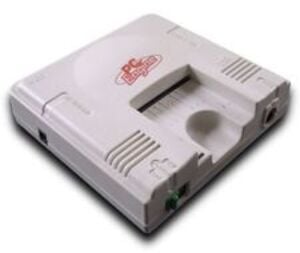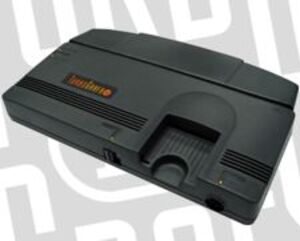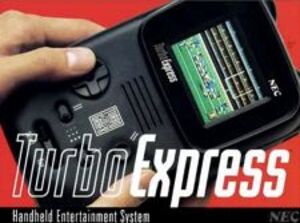
The history of the TurboGrafx-16 system is basically a tale of two countries. Electronics giant NEC and game developer Hudson joined forces in 1987 to design and release the PC Engine game console to compete head to head with Nintendo and Sega's 8-bit systems.
Offering a nice step up in terms of visuals and audio capabilities, the console immediately caught on with Japanese gamers and became one of the most successful consoles ever released in Japan. The PC Engine still sports one of the largest game libraries of any console ever released. But as successful as the PC Engine was in Japan, the console didn't fare nearly as well in other countries.
While it's a standard practice for Japanese console makers to wait several months before releasing their new consoles in the US, and sometimes even longer for a European release, NEC and Hudson waited almost a full two years before releasing the PC Engine system outside of Japan. In 1989 they released the system in the US changing the name to a more 'American-friendly' TurboGrafx-16. The system also saw a limited released in Europe as well. The biggest hurdle for the TurboGrafx-16 in the US and Europe was the lack of availability at retailers. NEC and Hudson decided to focus their marketing on the larger cities in the US and Europe and this caused a serious lack of availability at many retailers in the two countries. European gamers even resorted to importing the Japanese PC Engine systems and having RGB modifications performed on them in order to display on European PAL televisions.

The TurboGrafx-16 also had another obstacle to contend with. By the time the TurboGrafx-16 was released in the states, Sega was already about to drop their new 16-bit Genesis console onto US gamers and Nintendo was already creating a firestorm with news of their upcoming Super Nintendo system. Gamers in the US and Europe didn't want to hear about a game system they knew nothing about and couldn't find in most stores, let alone one that wasn't even as powerful as the upcoming Sega and Nintendo offerings. Needless to say, most gamers passed on the TurboGrafx-16.
The 16-bit era could just as easily be called the 'mascot' era. It seemed like every console maker sported some type of mascot for their system. Nintendo had Mario the plumber and Sega had Sonic the hedgehog. NEC was looking for anything that might spark sales of their failing TurboGrafx-16 system, so they too came up with a mascot in their lovable, but not terribly bright caveman, Bonk. Bonk's Adventure became one of the best-selling TurboGrafx-16 titles, but still wasn't enough to jump-start sales of the system. At this point, the Geico caveman couldn't have done much to help the faltering TurboGrafx-16 system.

In 1990 NEC decided to go after a piece of the handheld gaming market that Nintendo was thoroughly dominating with a portable version of their TurboGrafx-16 console. The Turbo Express was the first fully console-powered portable game system ever released. At $250 it was an impressive piece of technology, but the system required 6 'AA' batteries that would only provide about 2 hours of playing time. If you do the math, that gets expensive quickly. There was also a huge shortage of the systems when it was first launched, and many retailers that actually had the system in stock had jacked up the price to $399 to take advantage of the Christmas shopping season. The system would also be severely plagued by dead pixels, a common fault given how new the LCD technology was during this time period. Sadly, the Turbo Express did little to boost TurboGrafx-16 sales.
NEC had already released a CD-ROM attachment to their PC Engine system in Japan to rousing success when they decided to bring the system stateside. This new technology added some amazing features to gaming, but these new features came at a high price. The unit retailed for $399.99 and that was with no game included. NEC originally marketed this CD-ROM attachment in New York and Los Angeles, but would later make it available in limited quantities across the rest of the US. It really didn't matter, as most people didn't even own a TurboGrafx-16 system to attach it to anyway. Despite the many gaming advantages these CD-based titles offered, the technology was just too new and expensive for the average gamer to invest in. The failures were beginning to mount on NEC and Hudson, but they did manage one last ditch effort to keep their head above water in the console race.

In 1992 NEC and Hudson would unite to form TTI. The company developed an all-in-one TurboGrafx-16 and CD unit called the Turbo Duo system. This new unit also featured the newest version of the system cards that the CD system used, another unique feature of the TurboGrafx-16 system that most gamers outside of Japan never got to experience. The Turbo Duo would be aggressively marketed across the US, but by this time, most gamers were already heavily entrenched in the Sega Genesis and Super Nintendo systems and didn't have an additional $300 to throw down on yet another console. Sadly it was yet another TurboGrafx-16 system that would never really take off.
Over the years the TurboGrafx-16 and PC Engine systems have become one of the most collectable game consoles in history. Gamers around the net buy and sell these games and systems more now than they did back when the consoles were new. Some of the hard-to-find titles can fetch as much as $400 on internet auction sites. Nintendo's Wii console and its Virtual Console service have also resurrected the TurboGrafx-16 system by releasing classic game titles on a weekly basis. In fact, the TurboGrafx-16 titles have been among the best-selling games available on the Virtual Console to date. It seems that Virtual Console fans are finally finding out what TurboGrafx-16 fans have known all along.
Comments 28
I grew up with this system, while all of my friends had a Genesis or NES (barely any SNESs in my circle). Never knew there was so much hype or success (in Japan anyways) surrounding this console... and naturally I'm very happy to revisit these games on the VC.
Thanks for these articles! They are quite enjoyable. Looking forward to more...
Personally I had never heard of these consoles until the late 90s and then only by name, so I often wondered what they actually were. Given Hudsonsofts track record of fairly decent games (Especially the bomberman franchise and the underrated multiplayer ecstasy of battle loderunner), my guess that poor marketing and lack of foresight are clearly to blame for the consoles downfall. Playing these games now on the virtual console have really opened my eyes and it feels such a pity that I missed out on this all those years ago.
Great read! I'd never even heard of the console untill the VC appeared, and some of the games I've bought have been immense.
A nice little summary for those too young to know about the PCE - good work! The Engine didn't sell too well in Japan at first though, it was the release of R-Type that made gamers take notice.
I had a Duo a few years back and it's a shame the CD games won't make it onto the VC as there were tons of great titles. I'm really glad the PCE is getting some attention on VC as it had some classy titles (just look at Dragon's Curse, Ninja Spirit and Soldier Blade).
@ wildsnail
You never know. Nintendo and Hudson could put the Duo CD games on the VC. They will probably release other systems such as the Neo Geo first but you never know.
i never owned one of these but one of my friends in japan had one. from what i remember, the games were really cool. the ones that stick out in my mind are fist of the north star and r-type, the graphics seemed so ahead of their time ( for the mid-eighties anyway lol)
@Le Bla
The Wii just doesn't have enough on-board storage for CD-based games - even compressed,they are fairly large to download and store. Even some of the more modern Neo-cart games get pretty big so we'll have to wait and see if/when we ever get them (and what price). For now, we just have to appreciate the decent selection of PCE games they've released and wait for all the other good card-based titles still to come - roll on Devil Crash!!!
Really fun system... Only thing I truley never understood was...WHY THE SINGLE CONTROLLER MAN CMON! But besides that minor technicality.... The games were fun as hell and addicting- even the music would get stuck in my head for hours... I mean Bonks adventures was every way as good as SMB and Sonic in my eyes... Alien Crush was awesome... Blazing lazers was the coolest shooter ever.. and Splatterhouse was the best version by far on any system. I still have mine somewhere...
One of the great consoles that never made it to my area of the world.
Thankfully the Australian Virtual Console has recently got the TG-16 games so now I won't have to miss out on these great games.
If only Nintendo could do to us PAL region gamers like what Hudson did and give us the games that we never got the chance to play back in the day.
Love the pcengine......in the past ive owned a GT (jap + US ver) , Duo and a white PC Engine with cd rom.
Man, I grew up during the "golden age" of game consoles but I never even heard of this thing back then. It's a real shame, just think of how far video could've progressed if CD technology had caught on in the early 90s instead of half-a-decade later.
Great article! I grew up with the Turbografx 16, and I was one of the gamers who saved up $399 for the CD attachment (and an additional $75 for the Super System Card). Was it worth it? Absolutely! The games for that CD system were unlike anything I had ever seen, and like little I would see since.
Top titles: Ys' Books I and II (RPG), Cosmic Fantasy II (RPG), Vasteel (strategy), Lords of Thunder (shooter), Gate of Thunder (shooter), Dragon Slayer: The Legend of Heroes (RPG), Loom (adventure), and Prince of Persia (platformer).
Average: Buster Bros. (action), Sherlock Holmes (adventure), SimEarth (strategy), Y's 3, Shape Shifter (platformer), Splash Lake (puzzle)
Poor: Exile, Exile: Wicked Phenomenon, Magical Dinosaur Tour
I'm glad to see the Turbo discovered by a new audience and finally getting some of the recognition it deserves. Now if Nintendo would only release some of those CD titles....
It's cool to see this underrated console back in action.
When it was first annonced that the TG-16 was going to be on their VC service back in 2006, I did as much research as humanly possible because I had to know what it was. Since the console never caught on in the US, so I completely missed out on it (I had a NES and a SNES while one of my friends had a Genesis). Since then, I've mostly been downloading TG-16 games on my Wii and I love em as much as any other 8-16 bit game! Just something is unheard of in one country doesn't mean it sucks.
We already know how awesome the NES, SNES, N64, Genesis, and Neo Geo games are. Check out the power! Turbo power!
So like how do you put the games in and where do you plug in the controllers? Isn't there supposed to be 5 ports since i keep hearing about how using a gamecube controller counts as a fifth player?
@Boredom - The TurboGrafx only had one controller port by default. You had to use a turbo tap hardware add-on to add an extra 4 ports. You could get one that was styled like Bomberman's head. Awesome stuff
I was never a big fan of Turbografx 16 because I liked Super nintendo more, but Bonks adventuse was realy cool, and of course Castlevania: Rondo of blood. I dont now how much I will download from this console, but at least the castlevania game
The PC Engine was a mythical video games system to me back in the early nineties. I remember looking at screenshots of R-Type and Bonk in CVG magazine and Mean Machines (thanks guys) and being impressed by the colourful and detailed graphics. This is a great addition to the VC and I will definitely download Rondo of Blood when it is released in Europe. I highly recommend Bomberman '93 as it is the best multiplayer game on the VC so far in my opinion.
I wonder what the deal is with Europe not getting Bravoman or Ordyne. Two games and we would match the U.S.
I got my TurboGrafx-16 for Christmas when I was in high school. At the time, if you sent in your receipt and UPC code, you could get a free game. I still have it and the original box (with UPC code cut out). It still works like a dream and is one of the many systems I have hooked up. I loved my TG-16 and used to drool over the CD attachment and the TurboExpress handheld. I was really bummed when it began to fall behind in the console wars.
Many of the games that have come out on Virtual Console, I already have as a Turbochip (Blazing Lazers (the free game I got), Psychosis, Military Madness, J.J. and Jeff, R-Type, Legendary Axe, Bonk's Adventure and Bonk's Revenge, Alien and Devil's Crush and World Class Baseball.)
The PC Engine/TurboGrafx is THE BEST console for Shmup fans.
never heard of the system until i got the wii but ive purchased some games from it from the VC and they aren't bad at all
A multitap is needed just for 2 players? No wonder nobody I knew owned this thing back in the day. I never looked all that closely at the system when it was still alive, but that would have been a good enough reason not to buy it alone at the time.
@ Rootbeer: That was a definite negative. The way I justified it to myself back in the day was that most of the games I played were one player games anyway.
The pluses, I told myself, more than made up for it. The fact that it had an optional CD attachment that no other console had at the time. The TurboExpress handheld that played the exact same games as the home console. The fact that it was hugely popular in Japan. I thought there was no way it could fail. I didn't count on Sega having better marketing and distribution. Those two things killed the TurboGrafx. (Along with the fact that most of the best games never were released outside of Japan. They sent all the crap to NA.)
I never played a TG-16 game until Wii VC and It's brilliant, just like having a brand new 16 bit console released today.
Love it!
of course we have the Wii gaming system today but still have and play my turbo-grafx-16 games...years ago we also picked up the 4 port expander to be able to play 'bomberman' and 'final lap'...my favourite games today are the arcade game 'klax' and 'time ball' as well as 'r-type' 'sidearms' and 'keith courage'...still an excellent way to pass the time...we also still have x-box and nintendo (super too) and believe it or not the old atari system with some great games like 'yars revenge' and 'frostbite' and of course 'mario brothers'...
a great site...am enjoying the reads...the information and the game reviews...thanx
This is an awesome game system. I never owned it but the VC downloads are very good, and cheap too. I also like how you can just use the wiimote sideways.
I love the games, Military Madness is my favorite!
Back in 1989 The Turbo-grafx 16 system was the first videogame system that I bought with my own money. I decided to give this system a chance. Even though it lasted only 4 years. I got to play some great games. Military Madness, Alien Crush, Legendary Axe, Blazing Lazers, Dungoen Explorer. Monster Lair, and Cyber core.
Show Comments
Leave A Comment
Hold on there, you need to login to post a comment...